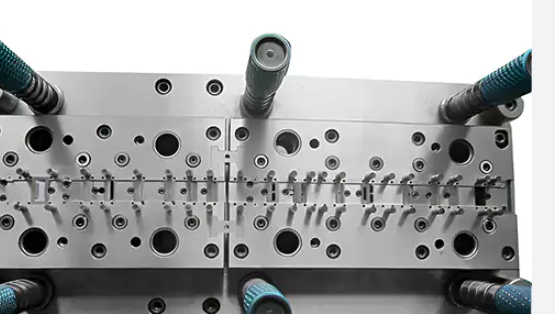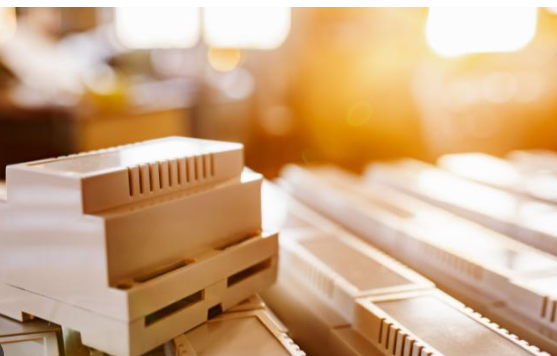In injection molding, lifters create simple undercuts, moving perpendicularly to mold opening, whereas slides form complex geometries by moving parallel.
Fundamentals of Injection Molding
Injection molding is a versatile manufacturing process primarily used for producing parts by injecting molten material into a mold. This process is widely applied in mass-production scenarios where the same part is being created thousands or even millions of times in succession.

Overview of Injection Molding Process
Injection molding begins with the melting of plastic material in the barrel of the machine. Once the plastic is in a molten state, it is injected into a mold cavity under high pressure. The injected plastic cools and solidifies, taking the shape of the cavity. This process can produce parts with complex shapes and fine details, making it ideal for a wide range of applications. The cycle time, which can vary from a few seconds to minutes depending on the size and complexity of the part, significantly impacts the overall production speed.
Key Components in Injection Molding Machines
Key components of injection molding machines include the hopper, where the plastic material is stored before being fed into the machine; the barrel, where the material is melted; and the screw, which mixes and propels the molten plastic into the mold. The clamping unit holds the mold in place under pressure, ensuring precise part formation. The machine’s power is a critical factor in its performance, with typical power ratings ranging from 15 to 6,000 tons of clamping force. The cost of these machines can vary significantly, from $25,000 for a basic model to over $150,000 for more advanced models, reflecting their efficiency and the quality of parts they produce.
Injection molding machines also have various specifications, such as the size and weight of the parts they can produce. These parameters define the range of products that can be manufactured. For example, machines with larger specifications can produce bigger parts but may require more power and incur higher costs.
The lifespan of these machines is another critical factor, typically ranging from 10 to 20 years, depending on their usage and maintenance. This long lifespan is essential for ensuring a good return on investment, as the initial cost can be substantial.
Materials used in injection molding vary widely, from thermoplastics like polystyrene and polyethylene to more advanced composites. The choice of material affects the quality and properties of the final product, such as strength, flexibility, and resistance to heat or chemicals.
Speed is another vital aspect, with faster machines capable of producing more parts in a shorter time, directly impacting production efficiency and costs. However, increased speed can sometimes compromise the quality of the parts produced.
Understanding Lifters in Injection Molding
Lifters in injection molding play a crucial role in creating complex and intricate parts. They are specialized components used to create undercuts in molded parts, which would otherwise be impossible to eject from a mold using traditional methods.
Role and Function of Lifters
Lifters are mechanically activated components that move in a direction different from the mold’s opening and closing. When the mold opens, the lifter moves at an angle, allowing for the creation of features like protrusions or recesses on the sides of the molded part. This movement is typically guided by angled pins or cams. The precise movement and positioning of lifters are essential for achieving the desired part geometry and ensuring smooth ejection of the part from the mold.
Types of Lifters and Their Applications
There are various types of lifters used in injection molding, each suited for specific applications:
- Standard Lifters: Commonly used for simple undercuts, these lifters are activated by the opening motion of the mold.
- Cam-Action Lifters: Ideal for more complex undercuts, these lifters use a cam mechanism for movement, offering greater control and precision.
- Collapsible Core Lifters: Used for creating internal undercuts, these lifters can collapse inward, allowing for the molding of complex internal geometries.
Each type of lifter finds its application based on the complexity and specificity of the undercut required in the part design. For example, collapsible core lifters are often used in applications like screw threads or intricate internal channels.
Advantages and Limitations of Using Lifters
Advantages of using lifters include:
- Enhanced Design Flexibility: Lifters allow for the creation of complex part geometries that are not possible with standard molding techniques.
- Reduced Need for Secondary Operations: Parts with undercuts can be molded in a single operation, reducing the need for post-molding machining.
- Improved Aesthetic and Functional Qualities: Lifters enable the design of parts with specific features that enhance their functionality or appearance.
However, there are also limitations to consider:
- Increased Mold Complexity: Incorporating lifters into a mold design can make the mold more complex and expensive to manufacture.
- Maintenance Requirements: Lifters can require additional maintenance due to their moving parts and the potential for wear and tear.
- Design Constraints: The use of lifters may impose certain constraints on part design, such as minimum angle requirements for effective ejection.
Exploring Slides in Injection Molding
Slides in injection molding are critical components that allow for the creation of parts with complex geometries and undercuts. Their functionality and design variations contribute significantly to the versatility of the molding process.
Functionality of Slides
Slides, also known as side-actions, move perpendicular to the action of the mold opening. They are used to form undercuts or recesses in the molded part that are not aligned with the mold’s pull direction. This functionality is essential for producing parts with features like holes, slots, or threads on lateral surfaces.
Key Points on Slide Functionality:
- Movement: Slides move in and out of the mold cavity to create the undercut.
- Timing: The motion of the slides is precisely timed with the mold opening and closing to ensure proper part formation and ejection.
- Mechanics: Slides are typically driven by hydraulic, mechanical, or pneumatic systems, depending on the mold design.
Different Designs of Slides
Slides vary in design to accommodate different molding requirements.
Types of Slides:
- Straight Slides: Simplest form, moving in a straight line, ideal for basic lateral undercuts.
- Angled Slides: Move at an angle, allowing for more complex undercut geometries.
- Lift-and-Turn Slides: Combine lifting and rotating actions, suitable for intricate designs.
Each design has its specific applications, chosen based on the complexity and location of the undercut in the part.
Pros and Cons of Slides in Molding Processes
Advantages of using slides include:
- Complex Geometries: Allow for the creation of parts with intricate designs and undercuts.
- Reduced Secondary Operations: Minimize the need for post-molding machining or assembly.
- Design Flexibility: Enable designers to incorporate complex features into a single part.
However, there are also drawbacks:
- Increased Mold Complexity: Complex slide mechanisms can make the mold design more complicated.
- Higher Costs: More intricate molds with slides are typically more expensive to manufacture and maintain.
- Maintenance Requirements: Slides, due to their moving parts, may require more frequent maintenance.
In terms of specific metrics:
- Lifespan: The lifespan of slide mechanisms can be impacted by their complexity, with simpler designs generally offering longer service life.
- Speed: The use of slides can affect the molding cycle time, potentially reducing overall production speed.
- Material Choice: The material used for the part and the slide mechanism can affect both the quality of the part and the durability of the slide.
Comparing Lifters and Slides
When it comes to injection molding, understanding the differences and applications of lifters and slides is essential for optimal mold design and product quality.
Mechanical Differences and Similarities
| Feature | Lifters | Slides |
|---|---|---|
| Movement Direction | Move perpendicular to the mold opening/closing | Move parallel to the mold opening/closing |
| Complexity | Less complex than slides | More complex due to lateral movement |
| Undercut Creation | Ideal for simple undercuts | Best for complex undercuts |
| Cycle Time Impact | Minimal impact on cycle time | Can increase cycle time due to additional movement |
Both lifters and slides are used to create undercuts in molded parts, but their mechanical operation and impact on the molding process differ significantly.
Selection Criteria: When to Use Lifters vs Slides
Choosing between lifters and slides depends on several factors:
- Part Design: Use lifters for simple undercuts and slides for more complex or lateral undercuts.
- Mold Complexity and Cost: Lifters are less complex and generally more cost-effective, while slides are more expensive and complex.
- Production Volume: For high-volume production, the choice may lean towards lifters due to their quicker cycle times.
Key Considerations:
- Material Used: The choice of material can impact the effectiveness and wear of these components.
- Maintenance Requirements: Slides typically require more maintenance due to their complexity.
Impact on Mold Design and Product Quality
The choice between lifters and slides significantly affects mold design and the quality of the final product.
| Aspect | Lifters | Slides |
|---|---|---|
| Mold Design Complexity | Less complex, easier to design and manufacture | More complex, requiring precision engineering |
| Product Quality | Suitable for high-quality production with simple designs | Enables high-quality production with complex geometries |
| Cost Implications | Generally lower cost in mold design and manufacturing | Higher cost due to complexity and precision requirements |
| Lifespan of Mold | Longer due to simpler mechanics | Potentially shorter due to more complex moving parts |
Case Studies and Applications
The use of lifters and slides in injection molding has led to significant advancements in product design and manufacturing efficiency. By examining real-world applications and industrial use cases, we can understand their impact on the industry.

Real-world Applications of Lifters
Lifters have been instrumental in manufacturing a variety of products where simple undercuts or internal features are necessary. A prime example is the production of electrical housing components. These parts often require internal clips or snaps that can be easily formed using lifters. The use of lifters in such applications not only simplifies the mold design but also reduces the overall manufacturing cost and time.
In the automotive industry, lifters are widely used for creating components like air vents, where the internal vanes can be effectively molded using lifter mechanisms. This method ensures high-quality parts with the necessary durability and aesthetic appeal, crucial in the automotive sector.
Industrial Use Cases for Slides
Slides, on the other hand, find their application in more complex part designs. In the medical industry, for instance, slides are used to produce intricate parts of medical devices. These components often require complex geometries for functionality, which slides can achieve with precision.
The consumer electronics sector also benefits greatly from slides. For example, the intricate internal structures of a smartphone case, which require precise and complex undercuts, are typically molded using slide mechanisms. This approach allows for the high-volume production of parts with consistent quality and intricate details.
Comparative Analysis of Successful Projects
When comparing successful projects that utilized lifters and slides, we observe distinct advantages in each approach depending on the project requirements. Projects that require simple undercuts and prioritize cost and production speed tend to favor lifters. In contrast, projects demanding complex geometries with precise details lean towards using slides, despite the higher cost and potentially longer production times.
A notable example is the production of gear housings in the automotive industry, where slides are used to create complex internal geometries. This approach, while more costly, results in superior product quality and functionality, which is essential in high-performance applications.




